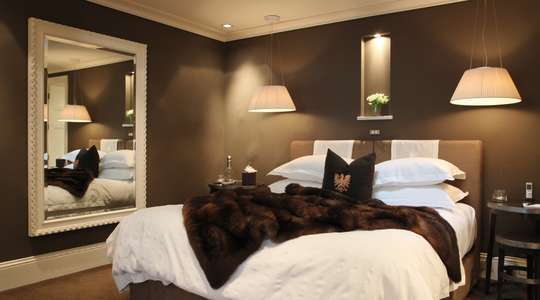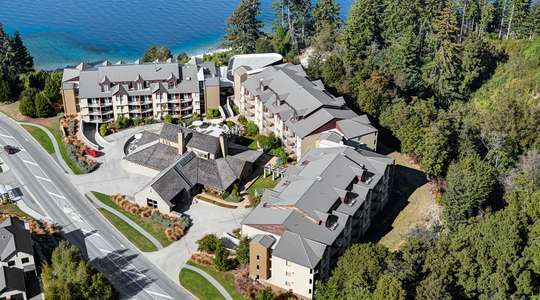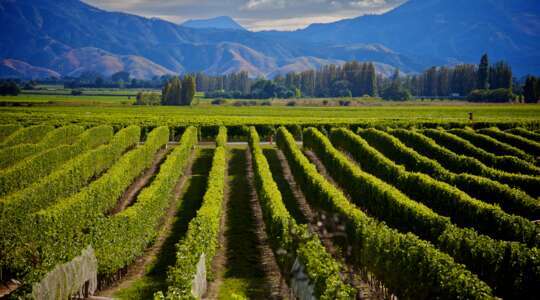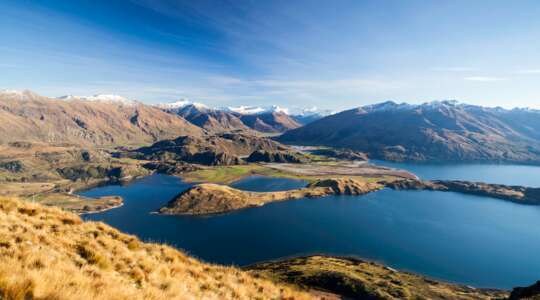Speak to one of our experts now about this offer
Call our New Zealand experts on0800 294 9729
Available until 5pm
Queenstown & Wanaka Holidays
From bungee jumps and canyon swings to lake cruises in spectacular surroundings, Queenstown & Wanaka offer a dizzying array of outdoor activities for all tastes.
Ice climbing in the majestic Remarkables Range, cutting up the dirt on an iconic mountain bike trail or plunging through the whitewater rapids in a rugged gorge: if you’re looking for an adrenaline rush, you’re sure to find it in Queenstown. It’s hard to imagine a more dramatic natural setting for ‘the adventure capital of the world’ than this – on the banks of a shimmering lake that skitters between the craggy peaks of the Southern Alps for 50 miles. You could come here and do nothing more heart-stopping than take in the majesty of the Middle Earth landscapes from the top of the town’s vertiginous cable car ride. For thrill-seeking visitors, though, the wild terrain provides a perfect playground, with soaring slopes to climb up and ski down, canyons to jump into and zipline through, and rushing rivers that only jet boats and inflatables can navigate.
Nearby Wanaka, on another of the South Island’s stretching-for-ever lakes, has a gentler, family-friendly appeal. Enjoy slow-paced adventures on the water by kayak or cruiser, hopping from secluded beaches to islands large enough to have lakes of their own. Pedal along the waterfront to take in quirky sights such as That Wānaka Tree, a small willow marooned – particularly photogenically – just offshore. Or take a walk: a spider’s web of footpaths and trails leads to local beauty spots, while the epic tracks of Mount Aspiring National Park are almost on the doorstep.
Call us about creating your ideal Queenstown & Wanaka holiday, whether you’re into daredevil activities or something more serene.
Queenstown & Wanaka Hotels
Our recommendations for the best places to stay in Queenstown & Wanaka
Holidays in Queenstown & Wanaka

- Queenstown & Wanaka
- 5 Star
An intimate sanctuary renowned for its impeccable service and breathtaking setting on the shores of Lake Wakatipu.

- Queenstown & Wanaka
- 4 Star
This homely hotel is in a stunning lakeside setting and has excellent activities.

- Queenstown & Wanaka
- 5 Star
Luxury lakeside boutique hotel

- Queenstown & Wanaka
- 4.5 Star
The ultimate alpine retreat

- Queenstown & Wanaka
- 4.5 Star
This contemporary alpine chic-style hotel overlooks Lake Wakaitpu and the Remarkables mountains and is just a short stroll from the lakefront.

- Queenstown & Wanaka
- 4 Star
Beautiful setting for outdoor activities

- Queenstown & Wanaka
- 4.5 Star
Check in at this new hotel for a distinctly designer vibe and views over breathtaking landscapes.

- Queenstown & Wanaka
- 5 Star
Classic French-inspired hotel
You may also like
Central Otago Food & Wine Tour
Depart from Queenstown for this full-day tour of the Central Otago Wine Region in the company of a wine-certified guide. Explore, taste and savour the flavours at four separate vineyards, both boutique and well established, around the wine regions of Bannockburn, Cromwell and Gibbston. A delicious lunch is served at the Bannockburn Hotel, where the restaurant has a 200-strong wine list. Try a range of varieties during the day including Blanc de Noir, Rosé and Pinot Noir, and a wine flight paired with a shared cheese platter at your final stop.
• Duration: full day
• Start time: 9.30am
• Departs Wednesday, Thursday and Sunday
• Operates November to March
• Group experience
Milford Sound from Queenstown
Depart from Queenstown and travel along through the picturesque Southland farming country to Te Anau. Continue to the Fiordland National Park and the renowned Milford Road. This corridor to the fjord unveils a different side of New Zealand, with its majestic mountains and winding rivers. Throughout the journey, there will be multiple stops for photo opportunities, short walks, and the chance to learn about the fascinating local facts and stories. Embark on a nature cruise that takes you beneath the towering peaks of the fjord. Admire spectacular alpine scenery and look out for unique wildlife including dolphins and seals, before heading back to Queensland.
• Duration: full day
• Start time: 7.30am
• Departs daily
• Operates year-round
• Group experience
Lord of the Rings Full Day Tour from Queenstown
Discover locations from The Lord of the Rings films on this 4x4 off-road adventure which departs from Queenstown. See The Remarkables (The Misty Mountains), Deer Park Heights (The Battle of the Wargs) and the Kawarau Gorge (Argonath/Pillars of the King) plus many more. Continue to Arrowtown and experience some off roading as you follow a gold mining road up the river where you can try gold panning before enjoying views of the Wakatipu Basin from Skippers Canyon.
• Duration: full day
• Start time: 8am
• Departs daily
• Operates year-round
• Group experience
Best of Queenstown
The landscapes surrounding Queenstown are legendary and you'll get to witness their beauty on this half-day scenic tour. The adventure begins as you head to a viewpoint for a panoramic vista of the town and its jaw-dropping backdrop and stop off for a quick peek at the Shotover River. There'll then be some time to explore Arrowtown, a historic settlement that built up around the gold mining industry, and watch the thrill-seekers at Kawarau, the site of the world's first commercial bungy jump; you can even have a go if you are feeling brave enough (at an extra cost). The next stop is a local winery where a tasting and shared cheeseboard is included (a non-alcoholic alternative is available for non drinkers). Before the return back to town, you'll hop on board a boat for a half-hour trip on Lake Whakatipu.
• Duration: half day
• Start time: 8.30am
• Daily departures
• Operates year-round
• Group experience
Queenstown Wine Sampler
Eighteen wines, four tastings, 6 hours; this whistlestop and award-winning tour of some of the Gibbston region's finest cellar doors gives you an unforgettable introduction to New Zealand's Pinot Noirs, Chardonnays and Chenins. Head to one of the areas founding wineries, home to the country's largest cellar, and Kinross, where five wine labels are sold and the lunch stop on this tour (payable locally). Mt Rosa Wines and The Church Cellar door follow, the former with a rich sheep-farming heritage and the latter with more of a religious past.
• Duration: 6 hours
• Start time: 10am
• Departs daily
• Operates year-round
• Group experience
Get to know Queenstown & Wanaka and those important practicalities when planning your perfect holiday.
GMT +12 (with New Zealand Daylight Time and New Zealand Standard Time applied, this largely equates to 11 hours ahead of the UK from early April to late September and 13 hours ahead from late September to late March)
New Zealand dollar
25½ hours (not including stopover time)
New Zealand has no state religion but the majority of people are Christian
Māori and English
Where are Queenstown & Wanaka?
The resort town of Queensland is in the South Island’s south west to the east of Fiordland and the Tasman Sea. It lies on an inlet on the Z-shaped Lake Wakatipu – the country’s longest – towards the bottom end of the Southern Alps. Queenstown Airport has regular direct flights from Auckland, Wellington and Christchurch, plus several Australian destinations, and is on the Southern Scenic Route if you’re touring by car or motorhome. A 50-minute drive to the north east across the Crown Range, Wanaka is on the shores of the lake of the same name and is the gateway to the glories of Mount Aspiring National Park.
Adventure capital
Hardy 19th-century mountaineers were the first to tackle the challenges of Queenstown’s environment for the sport of it, soon to be followed by summer hikers keen to immerse themselves in stunning scenery. It wasn’t until the 1950s, however, that Queenstown really began to take off as an outdoor-activity capital thanks to the launch of inventions such as ski tows and jet boats. The bungee jump was born here at the historic Kawarau Bridge in 1988 and has since spawned a host of other adrenaline-pumping options, including the world’s highest cliff jump. Tandem paragliding is another local creation – one of a host of ways to get a bird’s-eye view of the epic landscape.
Viewpoint & luge
For breathtaking vistas of Queenstown, take a ride on the recently upgraded Skyline Gondola. On the Southern Hemisphere’s steepest cable car, you’ll glide up to the top of Bob’s Peak, 480m above the town, where you can lap up the breathtaking panorama of The Remarkables, Lake Wakatipu and various peaks including Coronet, Walter and Cecil. From here, you can get your pulse racing – this is Queenstown, after all – on the Skyline Luge. Hop on the chairlift to the top, from where you’ll race back along a thrillingly twisting, winding track in a specially designed gravity-powered land cart to the beginning – where you can start all over again. Tickets are available for unlimited rides, just two or somewhere in between.
Lake Wakatipu
Occupying what geologists call an ‘over-deepened glacial trough’ carved out of hard metamorphic rock during the last Ice Age, Lake Wakatipu zigzags for 50 miles through the Southern Alps. Not just the country’s longest but also its third largest and fifth deepest lake, Wakatipu provides a habitat for at-risk New Zealand longfin eels along with landlocked Quinnat salmon, brown trout and rainbow trout. Not surprisingly, waterbirds are another feature, from great crested grebes and Pacific black ducks to endemic black teal. Scenic boat cruises are among Queenstown’s gentler activities – or you could try to emulate Ben Campbell-Macdonald, who became the first man to swim the length of the lake in 2012, a feat that took him 18.5 hours.
Gibbston wineries
About 25 minutes east of Queenstown, along the Karawau River valley, Gibbston is one of the six sub-districts of the Central Otago wine region. It’s known for its award-winning pinot noirs – courtesy of its mineral-rich soil, altitude and hot summers – which you can discover in all manner of enticing ways. Take a guided full- or half-day gourmet tour where your wine may be paired with artisanal chocolates, cheeses and the like, enjoy a self-guided pedal through some of the region’s oldest vineyards with a shuttle to whisk you and your bicycle back to town afterwards, or flit between boutique wineries by helicopter for a special treat. Gibbston also has some superb restaurants where you can eat (and drink) al fresco.
Tramping
There’s walking, hiking and then what the New Zealanders call tramping, which is altogether more adventurous: trekking for days and days through rough terrain for the sheer joy of it. And with two of New Zealand’s three largest and most remote national parks on the doorstep, Queenstown is a superb base to launch yourself into the backcountry equipped with cooking, sleeping and wet-weather gear. Local knowledge is invaluable, as many of the best routes are challenging – and the weather can be a factor – so we recommend setting out with a guide for the best and safest experience. For the time-pressed, heli-hiking trips will whirl you to remote beauty spots with a fraction of the effort.
Lake Wānaka
New Zealand’s fourth-largest lake is not just a scenic backdrop to the pretty town of Wanaka. Its crystal-clear waters are ideal for boating, whether you’re heading out by kayak to spend the day relaxing on a remote beach, feeling the wind in your sails as you slide through the magnificent scenery or venturing on a fishing expedition in search of a trout or salmon. There are several islands worth cruising to – on the nature walk on Mou Waho, for instance, you might come across one of the resident buff wekas, endangered flightless birds for whom this has become a sanctuary. Jet boat trips across the lake and into the braided rivers of Mount Aspiring National Park are another exciting possibility.
Mount Aspiring National Park
Sprawling across 878,000 acres of glacier-draped mountains and snowfields, forests, river valleys and alpine lakes, New Zealand’s third-largest national park is a paradise for walkers and hikers. If you’re fit and ambitious, you can follow the three-day Routeburn Track – one of the 10 New Zealand Great Walks – into Fiordland National Park or tramp the five-day Rees-Dart along winding riverbanks. Fortunately, a host of shorter routes offer a taste of the landscapes that became Lothlórien and Isengard in The Lord of the Rings film trilogy. A favourite is the Blue Pools Walk through the native beech forests flanking the Makarora River to a brace of swing bridges overlooking the crystal-clear waters that give the track its name.
Queenstown & Wanaka Weather
Dec - Mar
January
February
March
April
May
June
July
August
September
October
November
December
Sorry, your hotel is no longer available
Please check alternatives
-
{{item.body}}
-
{{item.body}}
Choose a departure date
{{store.searchDuration}} nights
Enter rooms & guests
Checking prices & availability

{{term}}, {{formattedDate}} for {{searchDuration}} nights







_w=24_h=25.png?v=910f6de5506872363a0d58b9f40775d869aae637)
_w=24_h=25.png?v=910f6de5506872363a0d58b9f40775d869aae637)
_w=24_h=25.png?v=910f6de5506872363a0d58b9f40775d869aae637)